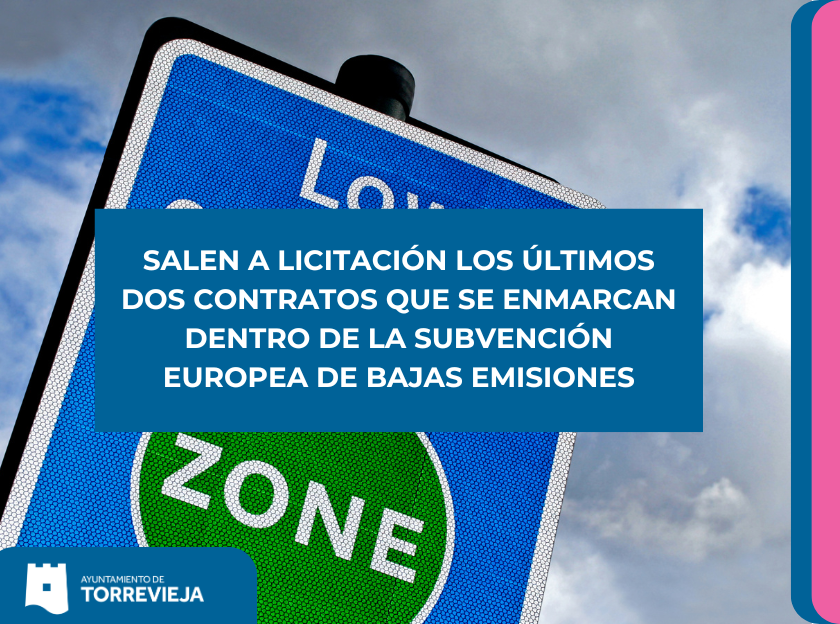The last two contracts under the European low-emissions subsidy are now out for tender.

The Secretary of the Local Government Board of the Torrevieja City Council, Federico Alarcón, reports that the last two technical and administrative specifications for the contracts that will complete the subsidy for the 2022 Low Emission Zone call, financed within component 1 - investment 1 of the PRTR, Next Generation-EU funds, and whose costs are 100% subsidized, excluding VAT, have been approved today.
This grant, worth €3,386,679 (€4,553,202 to be justified), aims to ease municipal expenditures by purchasing control materials and improving accessibility, facilitating pedestrian and non-polluting vehicle traffic in the city center, taking advantage of the obligation that all municipalities with more than 50,000 inhabitants have to establish a low-emission zone.
For this reason, and regardless of the phases in which it is subsequently implemented and with the aim of taking advantage of the subsidized resources to control traffic in the city center, it has been planned for the execution of the first contract, with a cost of 1,775,210 euros (1,467,116 euros + VAT), which covers lines P01 and P02 of implementation and complementary actions and includes the drafting of the technical project, as well as the supply, installation, configuration and start-up of the technological systems necessary for the implementation and operation of the Low Emission Zone (LEZ) in the municipality, in accordance with the provisions of Royal Decree 1052/2022 and Law 7/2021 on Climate Change and Energy Transition, that the actions will be located in two different areas that have been identified following technical criteria such as traffic density, environmental sensitivity or their strategic position, whose intervention entails an improvement in mobility and air quality.
TWO DIFFERENTIATED ZONES
First, we have the urban core, a central commercial area, which has a high density of traffic and commercial activity, resulting in a high concentration of emissions. However, its urban layout allows for the implementation of specific access points and controlled delimitation. This area is bordered to the north by San Pascual Street, to the south by Paseo Vistalegre, Paso de la Libertad, and Paseo Juan Aparicio, to the east by Patricio Zammit Street, and to the west by Avenida Faleria and Orihuela Street, where 13 access points to the LEZ will be located.
The second zone is formed by a ring parallel to the previous phase, encompassing the rest of the outlying urban area. Within it, we find 26 access points. This zone is bordered to the north by Bilbao, Santa Trinidad, San José, and Maestro Francisco Casanovas Streets; to the south by Gregorio Marañón Avenue, San Pascual Street, and Ramón y Cajal Streets; to the east by María Gil Vallejo Street, Virgen de la Paloma Street, and Orihuela Streets; and to the west by Villa de Madrid Street and Patricio Zammit Street.
Finally, there are cameras for compliance with and surveillance of the Low Emission Zone regulations. A minimum of 13 points have been planned, which will be located within the low-emission zones at points of interest and which may be expanded by the bidder.
The actions will include, among others, technical engineering services, mobility and emissions analysis, definition of technological solutions, drafting of the technical project, supply and installation of LPR cameras, environmental sensors, a comprehensive management platform, an operational control center, regulatory signage, as well as training and documentation. In addition, the contract includes the development and integration of the remaining complementary technological equipment (implementation of environmental sensors and management platform, mobile application, and communication campaign) to ensure the operational capacity of the Low Emission Zone.
Contract for the implementation of bicycle lane connections with low-emission zones and safe school routes
The second contract, with a base tender price of €1,245,603 (€1,029,424 + VAT), falls under lines P06 for pedestrian routes and P07 for safe school routes. It aims to improve pedestrian and bicycle access to the CEIP Acequión and CEIP Cuba schools in Torrevieja, as well as bicycle access to the city's LEZ (ZBE) from peripheral streets.
To this end, the sidewalks on the streets that connect to both schools will be widened using a system consisting of prefabricated modules that fit together and adapt to the existing sidewalk, both in plan and elevation, allowing for the narrower sidewalks to be extended without the need for civil engineering. Bike lanes will also be built on the streets adjacent to the schools, as well as on other streets in the city to connect the outlying area with the Low Emission Zone, providing continuity to existing ones where possible.
In addition to the lanes surrounding the schools, this contract includes two bike lanes. One includes the one that enters the LEZ from the north, starting from the sports area on Monge y Bielsa Avenue and extending along that avenue, and the bike lane on Delfina Viudes Avenue, which will be modified to improve its traffic characteristics. The other includes the one that enters the LEZ from the east, through Purísima Avenue, and will run along the entire coastal area of Torrevieja (Purísima, Mariano Ruiz Cánovas, Alfred Nobel, Martin Luther King, Marconi, and París Avenues). Vertical and horizontal signage complying with regulations, as well as bicycle parking both inside the schools and along the bike lanes to be built, are part of this contract.